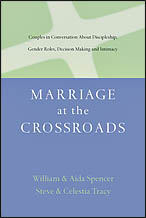Marriage at the Crossroads
 William D. & Aida Besancon Spencer and Steven R. & Celestia G. Tracy, Marriage at the Crossroads: Couples in Conversation about Discipleship, Gender Roles, Decision-Making and Intimacy (Downers Grove, IL: InterVarsity Press, 2009), 232 pages, ISBN 9780830828906.
William D. & Aida Besancon Spencer and Steven R. & Celestia G. Tracy, Marriage at the Crossroads: Couples in Conversation about Discipleship, Gender Roles, Decision-Making and Intimacy (Downers Grove, IL: InterVarsity Press, 2009), 232 pages, ISBN 9780830828906.
Marriage at the Crossroads is more like a forum or panel discussion reduced to print. The subtitle characterize the discussion as “conversations” between two couples on what makes an effective Christian “one-flesh marriage.” The couples involved are the authors, William D. and Aida B. Spencer of Gordon-Conwell Theological School and Steve and Celestia Tracy of Phoenix Seminary. The Spencers take an egalitarian position and the Tracys a complementarian viewpoint. “Conversations” is an appropriate description as polarization of viewpoints is entirely absent and dialogue is very much present. Both the Spencers and the Tracys consider mutual submission to Christ and to one another in discipleship as the critical element in marriage. For the Spencers an equality of the partners is assumed, an equality in which the husband and wife are “first in authority” with Christ as “ruler of the household” (p. 102). The partners together seek Christ’s wisdom on any given matter. For the Tracys, the partners complement each other affirming thereby that husband and wife have some gender-differentiated tasks, strengths and abilities, “all of which contribute to the joint marital mission” (p. 124). The husband’s “headship” or “authority” consists of lifting, strengthening, and being in personal intimacy with his spouse.
In many respects the differences between the Spencers and the Tracys appear to be more semantical than actual as there are several shared sentiments. “If we didn’t know better, we would say we had read each others chapters because they have each similar and overlapping content” (p. 182). There are five sections and a conclusion to Marriage at the Crossroads. Each of the first four chapters are further subdivided into three sections. The first chapter dealing with marriage and discipleship first present the viewpoint of the Spencers, then the Tracys’, and lastly, a concluding dialogue between the two as to what was learned from one another. This is repeated in the second chapter on “headship” and submission, but starting with the Tracys’ position and ending with a concluding dialogue. Chapter three dealing with marriage roles and decision making reverses the order of presentations with the Spencers stating their case. The Spencers delineate five aspects in the process of decision making and lay out six criteria for the basis of making decisions. The Tracys start their argument from the basis of innate gender differences and where these intersect with gender roles and how through “designer love,” “designer work,” and “designer parenting” decisions affecting each other and the children are made. The fourth chapter on “Marriage and Intimacy” begin with the Tracys views on developing intimacy and ends with the Spencers’ understanding of intimacy. Like the other three chapters, the fourth ends with a concluding dialogue on similarities, differences, and what was learned.
The fifth chapter was devoted to responses on the part of a North American Hispanic couple, a Second Generation Korean couple, and an African-American couple to the insights of both the Spencers and the Tracys as to how those would work out within their separate ethnic or racial situations given their cultural backgrounds.
The conclusion reached at the end of the book is that marriage has to first be a committed partnership within which personal interests are subsumed under the Lordship of Jesus and his leadership over their lives together. The book offers many valuable ideas and concepts that can be utilized by pastors and counselors who guide couples in life together in discipleship to Jesus.
Reviewed by Woodrow E. Walton
Preview this book online at: www.ivpress.com/cgi-ivpress/book.pl/code=2890
Category: Living the Faith, Summer 2010


